'Where prairie meets pine': Norquay, Sask., boasts spellbinding forested wilderness

CBC's virtual road trip series Land of Living Stories explores the hidden gems across Saskatchewan. You can invite CBC's Laura Sciarpelletti to your community for a virtual tour. Visit cbc.ca/lovesk to pitch your ideas.
As summer winds down, you may want to hit the lakes and campgrounds before it's too late. While there are great spots all over the province, the campsites and sprawling forests of eastern Saskatchewan provide a particularly spellbinding experience.
"Where prairie meets pine" is the slogan for the Norquay, Sask., a town about 240 kilometres northeast of Regina, near the Manitoba border.
That tagline could not be more accurate. There is a jolting change as you drive slightly north of Norquay into the thick forests surrounding Parr Hill Lake and Townsend Lake in Porcupine Hills Provincial Park.
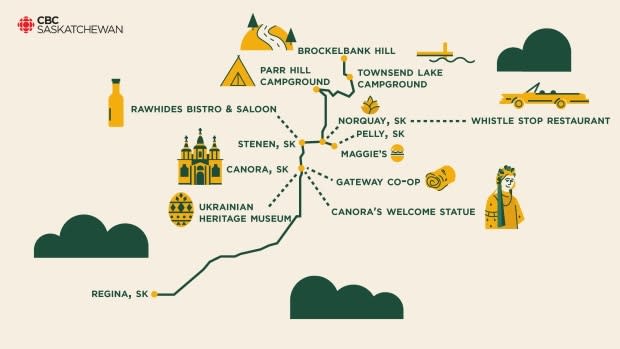
But before we get to the backwoods roads of eastern Saskatchewan, we've got a few stops to make.
Canora
On the way to Norquay, we hit the town of Canora, about 50 kilometres due north of Yorkton. The town has a prevalent Ukrainian community. In fact, when you drive into Canora, you are instantly welcomed by a large roadside statue of a Ukrainian woman named Lesia.
Canora is home to beautiful Ukrainian churches, and stopping by to take in their bright and ornate architecture is definitely a must.
Rose Remenda — a Ukrainian-Canadian who has lived in Canora for more than 40 years — says the land was very attractive to Ukrainian immigrants in the 1800s and 1900s.
"It was nice soil and a lot of people lived on the farms here. They were a really big Ukrainian settlement," Remenda said.
"I know that's why my grandparents came in 1897 — because they came by train from Halifax, and the train goes through our town, and they settled here.
"They had a lot of work to do. They had to clean up the bush to open up the prairies. They worked very hard."
Canora has had some special visitors throughout the years, like Queen Elizabeth II and Prince Phillip in 1987. The town welcomed the royal couple at Canora's civic centre, which doubles as a curling rink.
Dorothy Korol, who volunteers at the Ukrainian Heritage Museum with Remenda, remembers the visit very well.
"It was quite special to prepare. People came first to check out the hall and make sure it was up to snuff and so forth. And that was a special time," Korol said.
The town of Canora entertained the Queen with traditional Ukrainian dancing and a feast of perogies, cabbage rolls and headcheese.
Turns out, the Queen wasn't a fan of the headcheese.
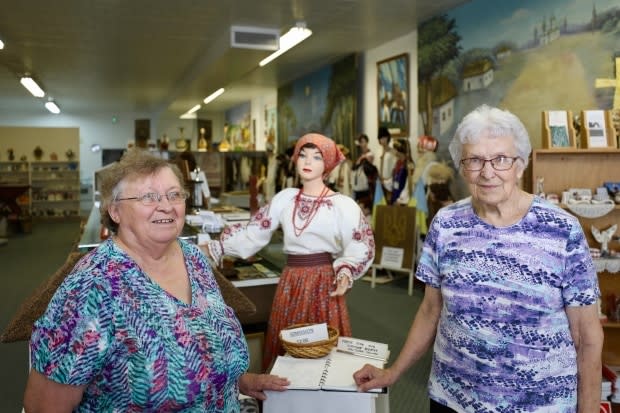
Many say that the Gateway Co-op in Canora has the best poppyseed roll in the province. Poppyseed is a popular ingredient in Ukrainian food, and the roll is a sweet bread with a swirl of poppyseeds on the inside.
The Co-op's rolls are so popular that many people stock up.
Donna Pasiechnik was born and raised in Canora, and now lives in Regina. Her sister and brother-in-law, who live in Vancouver, recently stopped by Regina on their way back from visiting Canora, driving their new Tesla electric car.
"My husband said to Ian, my brother-in-law, 'Hey, that's nice. So what's under the hood?' He was curious what an electric car looks like on the inside," Pasienchik said.
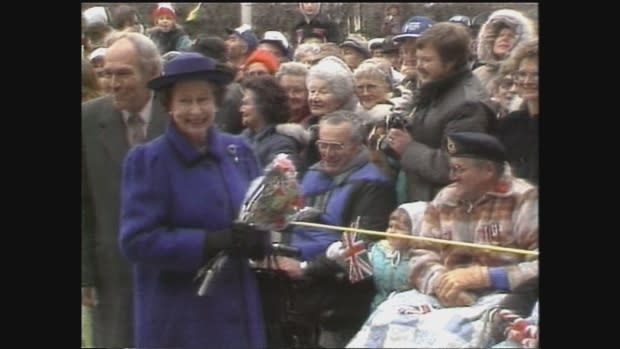
"So Ian flips over the hood ... and it's full of poppyseed rolls from the Canora bakery! It was a lot!"
Obviously, the Co-op poppyseed roll's reputation precedes it.
Listen to CBC's Laura Sciarpelletti take Morning Edition host Stefani Langenegger and listeners on a road trip:
Rawhides Bistro & Saloon
If we head about 30 kilometres north from Canora, we'll come to Rawhides Bistro & Saloon in Stenen — a true blast from the past.

Rawhides used to be an old brick school house. Now, it's a bustling Old West saloon, with three bars and a massive outdoor patio packed with country props. The restaurant has old metal seats, an old musket, Winchesters, barbed wire and saddles strewn everywhere.
It's a perfect pit stop for a truly packed plate, and great photo opportunities for you and your family.
Key First Nation
For David Howard Cote, the Key First Nation, located 20 kilometres from Norquay, is magical. Its hills, gullies and numerous lakes provide him with a connection to the land that he says he'll never lose.
"People always would ask me … 'usually [people] fly the coop when you're old enough' and blah, blah, blah. But it's too hard to leave this place. Because we're part of the land," Cote said.
"For me to try and go anywhere else and call it home ... I don't think I could."
Cote is a Saulteaux member of the Key First Nation. The ancestral land of the Indigenous peoples of the Key First Nation is the Shoal River region in southwestern Manitoba. Their homeland was part of the territory covered by the terms of Treaty 4 in 1874.
In 1880, the band and its chief, Chief Key, were relocated by government surveyors to the Fort Pelly district in Saskatchewan. Eventually, due to flooding concerns, they were moved again to the land they are now on.

"They were a mixed bag of Saulteaux people, Swampy Cree, and also Métis people as well, living amongst Chief Key and his people in that area," said Cote.
Some of those people trace their roots to the father of a band of brothers known as the Brass Brothers, who came to Saskatchewan in the 1700s from Orkney, an archipelago off the northeastern coast of Scotland, according to Cote.
He worked for the Hudson's Bay Company and married a First Nations woman, says Cote. They had sons who also eventually worked for the trading company.
"They got educated in the white way of language. They also learned their skills. So they were all boat builders, carpenters ... they were well to-do in the world of trades," said Cote.
"They were part of the band here that came with Chief Key. They married into that band."
Cote says the Brass Brothers were involved in the building of St. Andrew Anglican Church on the Key First Nation in the late 1800s.
The Brass Brothers and their offspring followed the Christian religion and attended the church, Cote says. And others of the band, such as Chief Key and his followers, practised their traditional religion.
"It's still kind of like that today on this reserve."
Cote says a lot of this history and knowledge comes from stories passed down to him by elders.
"Some of the old people still remember a lot of the old stories that they were told ... but a lot of that is starting to slowly fade away now. As time goes on they pass away, and a bit of history passes with them," Cote said.
"I like to laugh and joke around, but at the same time I really want to be a sponge and absorb as much knowledge as I can. Maybe I'll live to be an old-timer. I want to have something to tell future generations.
"That was always done with our people ... the tradition of oral history."
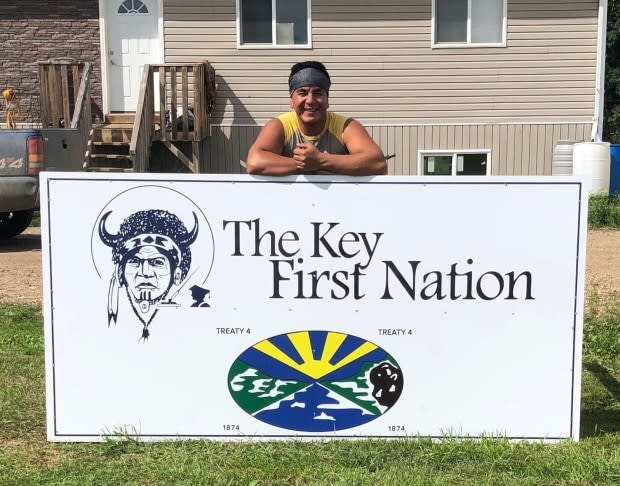
Norquay
Norquay is a small town that sits at the base of eastern Saskatchewan's northern wilderness. There are about 10 lakes within an hour-and-a-half drive of the town.
Locals spend a great deal of time at the Whistle Stop Family Restaurant in Norquay. Some meet for coffee there multiple times a day, trading hunting and fishing stories — and maybe a little gossip.
The Whistle Stop cafe is a retro '50s-inspired diner, with Marilyn Monroe and James Dean-themed bathrooms. And you can enjoy a burger with all the fixings from inside a convertible car — just like in Pulp Fiction!
Megan Peters has lived in Norquay for four years, and says she loves it because it feels like she's living in the bush.
"You'll see there's lots of farmland around here too, but there's lots of forests. It's really kind of earthy and green out here. It's beautiful. It smells great out here," said Peters.
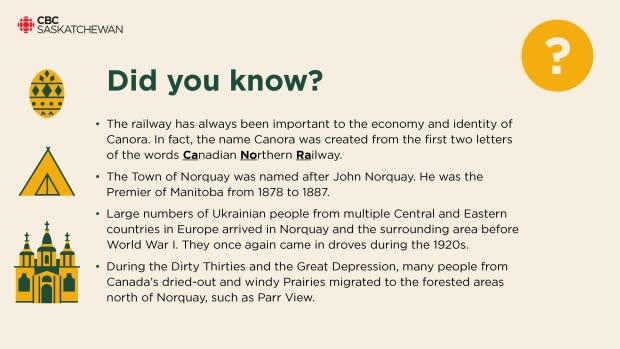
She loves camping at Parr Hill Lake, which is an hour north of Norquay, and Townsend Lake, which is an hour and a half northeast of the town. Those who live in the town of Norquay spend a great deal of time in the surrounding wilderness.
"It's all gravel and bush up there. I always think like if there was a zombie apocalypse I could probably just go north and be fine."
Parr Hill Lake & Townsend Lake campgrounds
Parr Hill Lake Campground sits nestled within a spruce forest of Porcupine Hills Provincial Park. Porcupine Hills is Saskatchewan's newest provincial park, officially designated in 2018.
Parr Hill Lake is located along the 982 logging road. This site is paradise for those who love to both unplug and fish. The campsite has no electrical hookups or cell service, but it has a boat launch and plenty of sparkling lake to catch walleye, northern pike and perch.
There is a stone path that leads from the lake's dock up to the campsite. The view of the spruce forest across the lake is easy to catch from your tent.
The Townsend Lake Campground is another fishing destination for campers who want a backwoods experience. Like Parr Hill Lake Campground, it's located in Porcupine Hills Provincial Park.
Campers fish for walleye, northern pike and perch not only at Townsend Lake, but at nearby Woody Lake and Elbow Lake.
Brockelbank Hill
And finally, if you drive only 30 minutes down the 980 Woody Lake logging road near the Manitoba border, and toward the town of Hudson Bay, you will come up on Brockelbank Hill.
It is very common to spot black bears and hordes of white-tailed deer along the side of the gravel road.
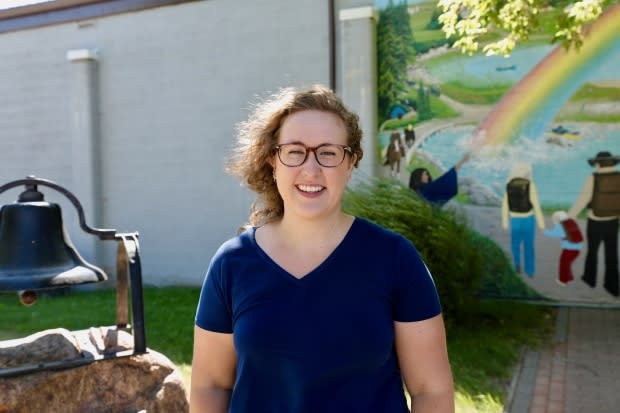
Brockelbank Hill is one of the most scenic and elevated spots in the province. The view from a bend in the road located in the Porcupine Hills is 810 metres above sea level.
It's unknown to many Saskatchewan residents, even some Norquay residents.
The view of forested landscapes and distant hills perfectly represents just how unique and spellbinding the terrain in eastern Saskatchewan is.
Listen to the Land of Living Stories Part. 4 playlist on YouTube.



